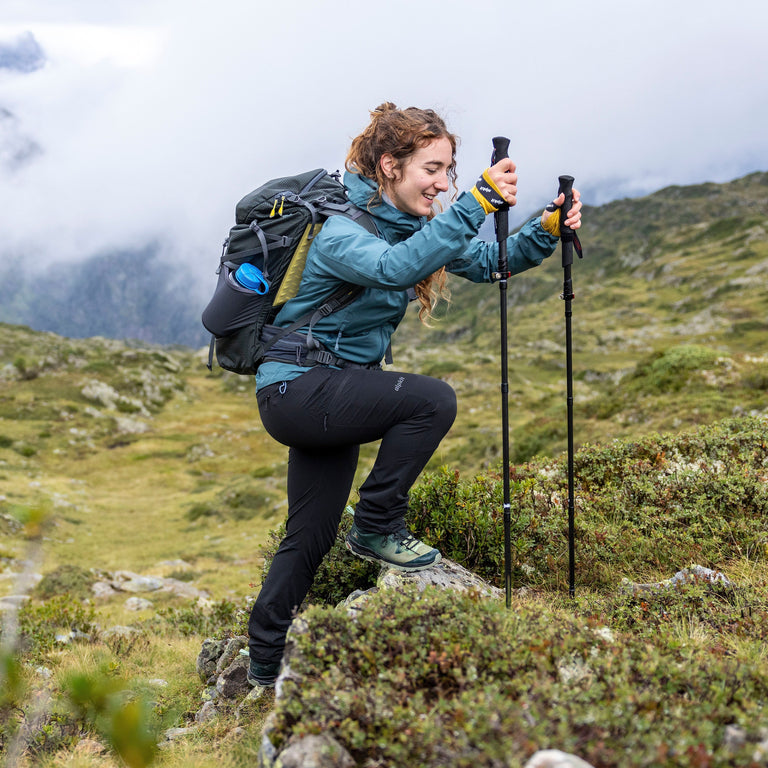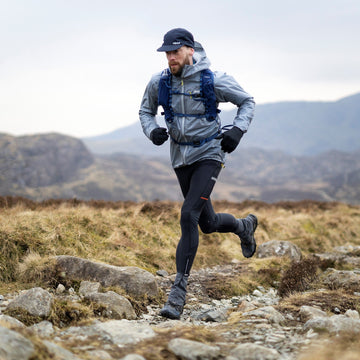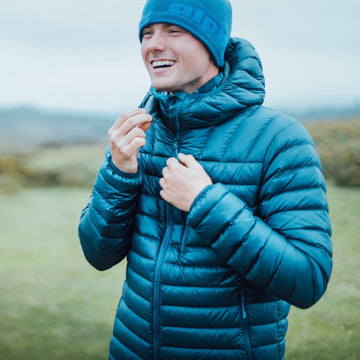
We’ve chosen a different path to waterproof performance — it helps us innovate faster, reduce our impact, and build award-winning jackets.
Gore-Tex is a legendary name in outdoor gear. It changed the game in the 1970s — finally giving us waterproofs that actually breathed. If you grew up in a sodden Peter Storm cagoule, the difference felt like magic.
But at Alpkit, we’ve never used Gore-Tex because, 50 years on, we believe there’s a better way.
Being independent from big component brands gives us the freedom to develop our own fabrics — with the best mills in the world — using latest developments with proven technologies that perform exceptionally and reduce environmental impact.
From Gravitas, our ultralight trail-running shell, to Definition, the first mountaineering jacket in the world to use a 3-layer fabric free from PFCs — here’s why we take a different path.
In this blog:
- What is Gore-Tex and why was it such a big deal?
- Is Gore-Tex still the best waterproof fabric?
- Why don’t Alpkit jackets use Gore-Tex?
- What fabrics does Alpkit use instead?
- How does this help reduce our environmental impact?
- Are Alpkit waterproofs any good?
What is Gore-Tex and why was it such a big deal?
Back in the 1970s, Gore-Tex changed everything. Before that, most waterproofs were essentially plastic bags with hoods — think Peter Storms and sweaty smocks. You stayed dry from rain, but soaked from your own sweat.
Gore-Tex introduced something new: a membrane that had tiny pores small enough to block rain, but big enough to let water vapour escape. Finally: waterproof and breathable.
Layer that membrane with a rugged face fabric (coated in a DWR to shed water) and a backer fabric for comfort — and you’ve got a 3-layer waterproof. It became the standard for decades.
Is Gore-Tex still the best waterproof fabric?
Gore-Tex make excellent fabrics. Period. But it's no longer the only game in town.
Today, multiple mills and manufacturers around the world produce high-performance waterproof-breathable membranes. Some use PU (polyurethane), others ePTFE, and newer options include mono-layer and bio-based membranes.
These alternatives can match or even exceed the performance of Gore-Tex — often with lower environmental impact, less rigid brand licensing, and more design flexibility.
Why don’t Alpkit jackets use Gore-Tex?
Because we’re free to do better.
Using Gore-Tex means more than just buying fabric. You sign up to a whole platform — with its own design constraints, licensing, and branding requirements. That works for some brands. But it’s not our style.
We’d rather stay nimble. Our independence lets us:
- Choose the right fabrics for each product, not just what’s in a licensed catalogue
- Work with the best mills in the world to create bespoke materials
- Innovate faster and bring new fabrics to market without waiting for a global brand to approve them
- Focus on reducing our impact, including eliminating PFCs and trialling mono-material membranes
That freedom is part of our DNA.
What fabrics does Alpkit use instead?
We’ve developed our own award-winning waterproofs using cutting-edge materials:
- Gravitas – an ultralight 3-layer shell using a PU-based membrane. Best in Test trail running jacket.
- Definition – world’s first PFC-free 3-layer mountaineering waterproof. Built for Scottish winter.
- Sigma – award-winning mono-polymer 3-layer waterproof for ultimate recyclability.
Each fabric is carefully chosen or developed for the specific demands of the jacket — from breathability to durability to repairability.
How does this help reduce our environmental impact?
Being independent allows us to act faster and take more responsibility for what we make.
Gore-Tex has historically used PFC-based DWR coatings — harmful “forever chemicals” that don’t break down in the environment. While they are phasing these out, progress has been slow. Even Patagonia lagged behind smaller brands on this.
At Alpkit:
- 100% of our waterproofs use PFC-free DWRs
- We’ve developed mono-polymer jackets like Sigma that can be more easily recycled at end of life
- We work only with mills that meet strict environmental and social standards
We’re not perfect. But we can move quickly and act decisively — because we’re not tied to legacy platforms.
Are Alpkit waterproofs any good?
We think so. But don’t just take our word for it.
Our waterproofs have won awards and been used on everything from fell runs to first ascents. Independent reviewers and customers rate them highly.
And we’re constantly improving — whether it’s swapping in recycled face fabrics, updating seam taping, or reducing microplastic shedding.
Plus, we keep things affordable and repairable for life. That’s real performance.
Conclusion
We don’t use Gore-Tex. Not because it’s bad — but because we believe we can do better.
Being free from big component brands lets us move fast, innovate boldly, and make jackets we’re proud of — high performance, low impact, and great value.









![Gravitas [Mens]](http://eu.alpkit.com/cdn/shop/files/mens-gravitas-2025-chilli.jpg?v=1765566317&width=768)
![Gravitas [Mens]](http://eu.alpkit.com/cdn/shop/files/gravitas-location-1-RETOUCH.jpg?v=1765566317&width=768)
![Gravitas [Womens]](http://eu.alpkit.com/cdn/shop/files/womens-gravitas-reef.jpg?v=1764270267&width=768)

![Fortitude [Mens]](http://eu.alpkit.com/cdn/shop/files/fortitude-mens-2025-alder.jpg?v=1765566372&width=768)

![Fortitude [Womens]](http://eu.alpkit.com/cdn/shop/files/fortitude-womens-2025-alder.jpg?v=1764270237&width=768)

![Balance [Mens]](http://eu.alpkit.com/cdn/shop/files/balance-mens-2025-reef.jpg?v=1767293796&width=768)
![Balance [Mens]](http://eu.alpkit.com/cdn/shop/files/Balance-mens-1.jpg?v=1767293796&width=768)
![Balance [Womens]](http://eu.alpkit.com/cdn/shop/files/balance-womens-2025-black.jpg?v=1767293873&width=768)
![Balance [Womens]](http://eu.alpkit.com/cdn/shop/files/Balance-womens-3.jpg?v=1767293873&width=768)

![Definition [Mens]](http://eu.alpkit.com/cdn/shop/files/Definition-men-2.jpg?v=1764357328&width=768)

![Definition [Womens]](http://eu.alpkit.com/cdn/shop/files/Definition-women-3.jpg?v=1764357395&width=768)



